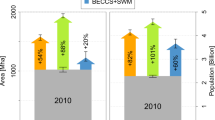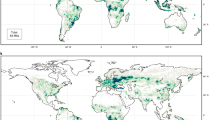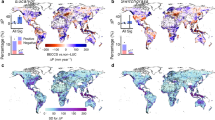Abstract
Bioenergy with carbon capture and storage (BECCS) is crucial in many stringent climate scenarios. Although irrigation can enhance BECCS potential, where and to what extent it can enhance global BECCS potential are unknown when constrained by preventing additional water stress and suppressing withdrawal of nonrenewable water resources. With a spatially explicit representation of bioenergy crop plantations and water cycle in an internally consistent model framework, we identified the irrigable bioenergy cropland on the basis of the water resources reserve. Irrigation of such cropland enhanced BECCS potential by only 5–6% (<60–71% for unconstrained irrigation) above the rain-fed potential (0.82–1.99 Gt C yr−1) by the end of this century. Nonetheless, it limited additional water withdrawal (166–298 km3 yr−1), especially from nonrenewable water sources (16–20%), compared with unconstrained irrigation (1,392–3,929 km3 yr−1 and 73–78%). Our findings highlight the importance of irrigation constraints in global BECCS potential.
This is a preview of subscription content, access via your institution
Access options
Access Nature and 54 other Nature Portfolio journals
Get Nature+, our best-value online-access subscription
$29.99 / 30 days
cancel any time
Subscribe to this journal
Receive 12 digital issues and online access to articles
$119.00 per year
only $9.92 per issue
Buy this article
- Purchase on Springer Link
- Instant access to full article PDF
Prices may be subject to local taxes which are calculated during checkout




Similar content being viewed by others
Data availability
The AIM/Hub and AIM/PLUM outputs are available from the website https://www-iam.nies.go.jp/aim/data_tools/aimssp/aimssp.html. The input meteorological data are available at http://h08.nies.go.jp. All datasets used in this study are also available from the corresponding author on reasonable request.
Code availability
The code and technical information about the H08 model are available at http://h08.nies.go.jp. The code used for the simulation is also available from the corresponding author on reasonable request.
References
Synthesis Report on the Aggregate Effect of the Intended Nationally Determined Contributions (UNFCCC, 2015).
Slade, R., Bauen, A. & Gross, R. Global bioenergy resources. Nat. Clim. Change 4, 99–105 (2014).
Smith, P. et al. Biophysical and economic limits to negative CO2 emissions. Nat. Clim. Change 6, 42–50 (2015).
Minx, J. C. et al. Negative emissions—part 1: research landscape and synthesis. Environ. Res. Lett. https://doi.org/10.1088/1748-9326/aabf9b (2018).
Rogelj, J. & Knutti, R. Geosciences after Paris. Nat. Geosci. 9, 187–189 (2016).
Rogelj, J. et al. Scenarios towards limiting global mean temperature increase below 1.5 °C. Nat. Clim. Change 8, 325–332 (2018).
Daioglou, V., Doelman, J. C., Wicke, B., Faaij, A. & van Vuuren, D. P. Integrated assessment of biomass supply and demand in climate change mitigation scenarios. Glob. Environ. Change 54, 88–101 (2019).
Muratori, M. et al. EMF-33 insights on bioenergy with carbon capture and storage (BECCS). Climatic Change https://doi.org/10.1007/s10584-020-02784-5 (2020).
Yamagata, Y. et al. Estimating water–food–ecosystem trade-offs for the global negative emission scenario (IPCC–RCP2.6). Sustain. Sci. 13, 301–313 (2018).
IPCC: Summary for Policymakers. In Special Report on Climate Change and Land (eds Shukla, P. R. et al.) (IPCC, 2019).
Stokstad, E. Bioenergy not a climate cure-all, panel warns. Science 365, 527–528 (2019).
Heck, V., Gerten, D., Lucht, W. & Popp, A. Biomass-based negative emissions difficult to reconcile with planetary boundaries. Nat. Clim. Change 8, 151–155 (2018).
Reid, W. V., Ali, M. K. & Field, C. B. The future of bioenergy. Glob. Change Biol. 26, 274–286 (2020).
Hejazi, M. I. et al. 21st century United States emissions mitigation could increase water stress more than the climate change it is mitigating. Proc. Natl Acad. Sci. USA 112, 10635–10640 (2015).
Fujimori, S. et al. Inclusive climate change mitigation and food security policy under 1.5 °C climate goal. Environ. Res. Lett. 13, 074033 (2018).
Humpenöder, F. et al. Large-scale bioenergy production: how to resolve sustainability trade-offs? Environ. Res. Lett. https://doi.org/10.1088/1748-9326/aa9e3b (2018).
Fuss, S. et al. Betting on negative emissions. Nat. Clim. Change 4, 850–853 (2014).
Creutzig, F. et al. Bioenergy and climate change mitigation: an assessment. Glob. Change Biol. Bioenergy 7, 916–944 (2015).
Boysen, L. R., Lucht, W. & Gerten, D. Trade-offs for food production, nature conservation and climate limit the terrestrial carbon dioxide removal potential. Glob. Change Biol. 23, 4303–4317 (2017).
Beringer, T. I. M., Lucht, W. & Schaphoff, S. Bioenergy production potential of global biomass plantations under environmental and agricultural constraints. Glob. Change Biol. Bioenergy 3, 299–312 (2011).
Bonsch, M. et al. Trade-offs between land and water requirements for large-scale bioenergy production. Glob. Change Biol. Bioenergy 8, 11–24 (2016).
Stenzel, F., Gerten, D., Werner, C. & Jägermeyr, J. Freshwater requirements of large-scale bioenergy plantations for limiting global warming to 1.5 °C. Environ. Res. Lett. https://doi.org/10.1088/1748-9326/ab2b4b (2019).
Berndes, G. Bioenergy and water—the implications of large-scale bioenergy production for water use and supply. Glob. Environ. Change 12, 253–271 (2002).
Hanasaki, N. et al. A global water scarcity assessment under Shared Socio-economic Pathways—part 1: water use. Hydrol. Earth Syst. Sci. 17, 2375–2391 (2013).
Hanasaki, N. et al. A global water scarcity assessment under Shared Socio-economic Pathways—part 2: water availability and scarcity. Hydrol. Earth Syst. Sci. 17, 2393–2413 (2013).
Hejazi, M. I. et al. Integrated assessment of global water scarcity over the 21st century under multiple climate change mitigation policies. Hydrol. Earth Syst. Sci. 18, 2859–2883 (2014).
Séférian, R., Rocher, M., Guivarch, C. & Colin, J. Constraints on biomass energy deployment in mitigation pathways: the case of water scarcity. Environ. Res. Lett. https://doi.org/10.1088/1748-9326/aabcd7 (2018).
Wada, Y., Gleeson, T. & Esnault, L. Wedge approach to water stress. Nat. Geosci. 7, 615–617 (2014).
Mouratiadou, I. et al. The impact of climate change mitigation on water demand for energy and food: an integrated analysis based on the Shared Socioeconomic Pathways. Environ. Sci. Policy 64, 48–58 (2016).
Stenzel, F. et al. Irrigation of biomass plantations may globally increase water stress more than climate change. Nat. Commun. 12, 1512 (2021).
Springmann, M. et al. Options for keeping the food system within environmental limits. Nature 562, 519–525 (2018).
Kato, E. & Yamagata, Y. BECCS capability of dedicated bioenergy crops under a future land-use scenario targeting net negative carbon emissions. Earths Future 2, 421–439 (2014).
Daioglou, V. et al. Greenhouse gas emission curves for advanced biofuel supply chains. Nat. Clim. Change 7, 920–924 (2017).
AQUASTAT Database (FAO, 2016); http://www.fao.org/nr/water/aquastat/data/query/index.html?lang=en
Hanasaki, N., Yoshikawa, S., Pokhrel, Y. & Kanae, S. A global hydrological simulation to specify the sources of water used by humans. Hydrol. Earth Syst. Sci. 22, 789–817 (2018).
Rogelj, J. et al. A new scenario logic for the Paris Agreement long-term temperature goal. Nature 573, 357–363 (2019).
Jans, Y., Berndes, G., Heinke, J., Lucht, W. & Gerten, D. Biomass production in plantations: land constraints increase dependency on irrigation water. Glob. Change Biol. Bioenergy 10, 628–644 (2018).
Fajardy, M., Chiquier, S. & Mac Dowell, N. Investigating the BECCS resource nexus: delivering sustainable negative emissions. Energy Environ. Sci. 11, 3408–3430 (2018).
Galik, C. S. A continuing need to revisit BECCS and its potential. Nat. Clim. Change 10, 2–3 (2019).
Mander, S., Anderson, K., Larkin, A., Gough, C. & Vaughan, N. The role of bio-energy with carbon capture and storage in meeting the climate mitigation challenge: a whole system perspective. Energy Procedia 114, 6036–6043 (2017).
Rogelj, J. et al. in Special Report on Global Warming of 1.5 °C (eds Masson-Delmotte, V. et al.) Ch. 2 (IPCC, WMO, 2018).
Jones, M. B. & Albanito, F. Can biomass supply meet the demands of bioenergy with carbon capture and storage (BECCS)? Glob. Change Biol. https://doi.org/10.1111/gcb.15296 (2020).
Butnar, I. et al. A deep dive into the modelling assumptions for biomass with carbon capture and storage (BECCS): a transparency exercise. Environ. Res. Lett. https://doi.org/10.1088/1748-9326/ab5c3e (2019).
Heck, V., Gerten, D., Lucht, W. & Boysen, L. R. Is extensive terrestrial carbon dioxide removal a ‘green’ form of geoengineering? A global modelling study. Glob. Planet. Change 137, 123–130 (2016).
Hanssen, S. V. et al. Biomass residues as twenty-first century bioenergy feedstock—a comparison of eight integrated assessment models. Climatic Change 163, 1569–1586 (2020).
Hanssen, S. V. et al. The climate change mitigation potential of bioenergy with carbon capture and storage. Nat. Clim. Change 10, 1023–1029 (2020).
Hanasaki, N. et al. An integrated model for the assessment of global water resources—part 1: model description and input meteorological forcing. Hydrol. Earth Syst. Sci. 12, 1007–1025 (2008).
Hanasaki, N. et al. An integrated model for the assessment of global water resources—part 2: applications and assessments. Hydrol. Earth Syst. Sci. 12, 1027–1037 (2008).
Ai, Z., Hanasaki, N., Heck, V., Hasegawa, T. & Fujimori, S. Simulating second-generation herbaceous bioenergy crop yield using the global hydrological model H08 (v.bio1). Geosci. Model Dev. 13, 6077–6092 (2020).
Shirakawa, N. Global estimation of environmental flow requirement based on river runoff seasonality. Annu. J. Hydraulic Eng. 49, 391–396 (2005).
Hanasaki, N. H08 Manual User’s Edition 2nd edn (National Institute for Environmental Studies, 2019); https://h08.nies.go.jp/h08/files/USERen_20190701.pdf
The World Database on Protected Areas (WDPA) (UNEP-WCMC, 2015); www.protectedplanet.net
Wu, W. et al. Global advanced bioenergy potential under environmental protection policies and societal transformation measures. Glob. Change Biol. Bioenergy https://doi.org/10.1111/gcbb.12614 (2019).
Lehner, B. & Döll, P. Development and validation of a global database of lakes, reservoirs and wetlands. J. Hydrol. 296, 1–22 (2004).
Fujimori, S., Hasegawa, T., Ito, A., Takahashi, K. & Masui, T. Gridded emissions and land-use data for 2005–2100 under diverse socioeconomic and climate mitigation scenarios. Sci. Data 5, 180210 (2018).
Fujimori, S., Masui, T., & Matsuoka, Y. AIM/CGE [Basic] Manual Discussion Paper No. 2012-01 (Center for Social and Environmental Systems Research, 2012).
Hasegawa, T., Fujimori, S., Ito, A., Takahashi, K. & Masui, T. Global land-use allocation model linked to an integrated assessment model. Sci. Total Environ. 580, 787–796 (2017).
Frieler, K. et al. Assessing the impacts of 1.5 °C global warming—simulation protocol of the Inter-Sectoral Impact Model Intercomparison Project (ISIMIP2b). Geosci. Model Dev. 10, 4321–4345 (2017).
Acknowledgements
Z.A. and N.H. were supported by the Environment Research and Technology Development Fund (JPMEERF20202005 and JPMEERF15S11418) of the Environmental Restoration and Conservation Agency of Japan. T.H. and S.F. were supported by the Environment Research and Technology Development Fund (JPMEERF20211001) of the Environmental Restoration and Conservation Agency of Japan and the Sumitomo Foundation. T.H. was supported by the Ritsumeikan Global Innovation Research Organization (R-GIRO), Ritsumeikan University. We thank K. Takahashi, W. Wu and Y. Satoh for the discussion and technical support.
Author information
Authors and Affiliations
Contributions
N.H. and Z.A. conceived the research and designed the scenarios; Z.A. developed the code, conducted the simulation, analysed the data and prepared the manuscript; T.H. and S.F. contributed to the scenario design; N.H., V.H., T.H. and S.F. edited and improved the manuscript.
Corresponding author
Ethics declarations
Competing interests
The authors declare no competing interests.
Additional information
Peer review Information Nature Sustainability thanks Vaibhav Chaturvedi and the other, anonymous, reviewer(s) for their contribution to the peer review of this work.
Publisher’s note Springer Nature remains neutral with regard to jurisdictional claims in published maps and institutional affiliations.
Supplementary information
Supplementary Information
Supplementary Tables 1 and 2 and Figs. 1–12.
Rights and permissions
About this article
Cite this article
Ai, Z., Hanasaki, N., Heck, V. et al. Global bioenergy with carbon capture and storage potential is largely constrained by sustainable irrigation. Nat Sustain 4, 884–891 (2021). https://doi.org/10.1038/s41893-021-00740-4
Received:
Accepted:
Published:
Issue Date:
DOI: https://doi.org/10.1038/s41893-021-00740-4
This article is cited by
-
Potential of land-based climate change mitigation strategies on abandoned cropland
Communications Earth & Environment (2023)
-
Increased precipitation over land due to climate feedback of large-scale bioenergy cultivation
Nature Communications (2023)
-
Contrasting area and yield responses to extreme climate contributes to climate-resilient rice production in Asia
Scientific Reports (2023)
-
Irrigation in the Earth system
Nature Reviews Earth & Environment (2023)



